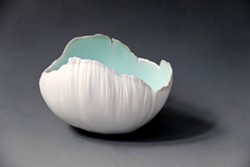[
{
"name": "Top Stories Video Pair",
"insertPoint": "7",
"component": "17087298",
"parentWrapperClass": "fdn-ads-inline-content-block",
"requiredCountToDisplay": "1"
}
]
Lacey mist clings to the forested watersheds that circle the city of Jingdezhen. Spindly smokestacks puncture the skyline like branchless trees, competing with modern high-rise apartments. Sports cars speed past endless shops filled with vases, bowls, cups, teapots, Buddha sculptures and any other shape that can be made from clay.
Jingdezhen, like most cities in China, is rapidly transforming into a 21st century metropolis, but its reputation was forged a millennium ago. Jingdezhen is the birthplace of porcelain and has helped define an entire nation with the perfection of its ceramics. For nearly a thousand years, Chinese potters cornered the market with pristine white vessels that spanned the globe through maritime trade and Silk Road excursions. European kings spent fortunes attempting to replicate Jingdezhen's treasures. To this day the city still holds worldwide dominance in the field.
Geographic luck has played a big role in Jingdezhen's ceramic prominence. Pure white kaolin, the primary ingredient in porcelain, is abundant in the area. Plentiful forests and coal deposits provided fuel for ancient kilns. Major rivers such as the Yangtze allowed for easy import of raw materials and export of finished goods. Up, down, left or right, porcelain coats the city from shops to street lamps to traffic lights, wall decorations and even garbage cans. Jingdezhen Ceramic Institute, the town's university, protects and promotes the vast trove of ceramic knowledge inherent to this place.
Naturally, such a wealth of ceramic history has attracted clay enthusiasts from across the globe (I visited the city a decade ago). Shannon Sullivan, an art professor at College of the Redwoods, recently spent about a month there. During her residency at the Pottery Workshop, a contemporary-arts focused institute located in the historic Sculpture Factory, Sullivan challenged herself to work with the unique qualities of Jingdezhen porcelain and embrace the division of labor that has made the porcelain city so successful.
"You can easily visit Jingdezhen as an artist or designer and think like a project manager," she says. Each step of the production process has been refined to the point where throwers, trimmers, mold makers, glazers and kiln experts focus exclusively on one area of expertise. It's amazing, Sullivan says, "how good you can get at something when you share the labor so you don't have to be really good at every little facet of your process." In a city of 1.5 million, "it's a very efficient way to use people power."
Sullivan found herself contracting out certain parts of the creative process so she could spend her limited time wisely. While master mold makers and casters generated parts she would later assemble, Sullivan studied relief carving, ceramic decals and celadon glazes. "Having that opportunity for me was pretty interesting because I had never shared the labor before," she recalls. Indeed, the idea of shared labor is integral to the workflow in Jingdezhen, but foreign in the minds of American potters. As she pulled new pieces from public kilns, Sullivan appreciated the efficiency of the process, noting that "you can get a lot of work done that way."
As part of CR's "Portugal Award," which honors outstanding faculty in memory of the university's first president, Sullivan assembled an exhibition that brings a slice of Jingdezhen's fine art world back to the North Coast. In a city of deeply ingrained, mass-industrialized pottery production, Jingdezhen has only just recently begun to spread its fine art wings. With works from across the globe, Post China: A Ceramic Journey features wares by more than 30 artists that were either produced in or inspired by time spent in Jingdezhen. The diversity of techniques, concepts and forms is stunning when you consider that they all began as lumps of shapeless, white clay.
For example, Yixing Lin's delicate vessels exemplify the materiality of Jingdezhen porcelain. A native to the city, Lin's petal-thin and slightly cupped forms "celebrate the whiteness of the porcelain and the juicy viscosity of the celadon glaze," according to Sullivan. Under bright gallery lights, their candy-colored interiors tint a satiny exterior of brilliant white unglazed clay. Recalling bone china teacups, the elusive shapes pull curious comparisons to tulips or aquatic creatures. Thin yet strong, smooth yet coarse, Lin's pieces exalt porcelain's celebrated aesthetic through quiet contradictions.
Across the room and hung on the wall, Christa Assad's piece takes a more traditional approach. About 10 inches wide, her thrown shallow bowl is slightly altered with six hexagonal points darting its rim. Cobalt decals collected in Jingdezhen are collaged across the face of the piece, smeared and blotted, fussy yet sophisticated. Heavy, angled iron stains fasten hard to the surface, dripping like steel upon silk. The root motif in Assad's decals are no mistake; like DNA strands, the shapes reference her work's historic lineage while their broken blue hints at a new future for ceramic art.
Thousands of years of tradition and culture permeate Jingdezhen's porcelain. Given clay's utilitarian basis and Jingdezhen's mass-market economy, it's refreshing to see one-of-a-kind works emerge from under such heavy history. In Post China, Sullivan has done more than gather like-minded ceramic artists. The show celebrates the medium, parades its diversity and underscores a growing, creative movement in porcelain's home town.
Post China is at at CR's Creative Arts Gallery gallery through March 27. Find links to videos, more photos and pictures of Jingdezhen on CR's website.
more from the author
-
The Prolific Hermit
Painter John Motian at Piante Gallery
- Feb 5, 2015
-
Perfectly Imperfect
Lauryn Axelrod's wabi-sabi vessels at Fire Arts Center
- Jan 8, 2015
-
Home Grown
Redwood Art Association goes Off the Wall
- Jan 1, 2015
- More »

































